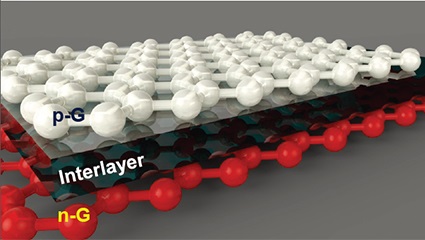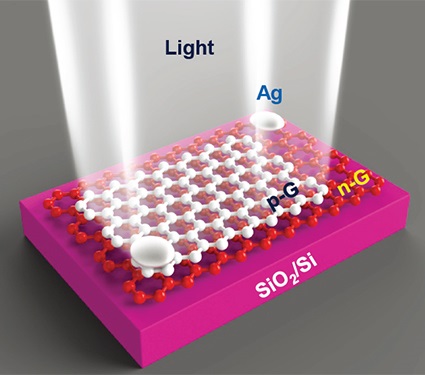May 08, 2014
Professor Suk-Ho Choi and his research team of the Department of Applied Physics developed an all-graphene p-n vertical junction photodetector with high photoresponsivity.
The research findings were published in the online edition of Nature Communications on February 12, 2014. The research was jointly conducted by Professor Suk-Ho Choi, Professor Sung Kim, and a postdoctoral researcher Chango Kim from the Nanostructure and Display Lab of Kyung Hee University and Professor Euyheon Hwang from the Advanced Institute of Nano-Technology of Sungkyunkwan University.

Utilizing all-graphene p-n vertical-type tunneling diodes
Professor Suk-Ho Choi had already developed an all-graphene semiconductor device last year and published the research findings in the online edition of ACS Nano, a world-renowned nano science journal, on May 21, 2013. Using that as a launching pad, Professor Choi utilized the aforementioned all-graphene p-n vertical-junction tunneling diodes to produce the photodetector involved in this research. Professor Choi’s team discovered that, in terms of photoresponsivity, the all-graphene p-n vertical junction photodetector either matched or outperformed the conventional silicon or indium gallium arsenide devices, particularly achieving a high responsivity (0.4~1.0AW-1) in the broad spectral range from ultraviolet to near-infrared. Silicon and indium gallium arsenide are considered to be unsuitable for the next-generation optoelectronic apparatus because their rigidity and opacity severely limit their use in a flexible and transparent device.
Graphene-based photodetectors then received much attention as an alternative due to their natural flexibility and transparency, but graphene was plagued by a much lower photoresponse performance compared to the conventional material. The photodetector developed by Professor Choi’s team, therefore, represents a technical breakthrough in that it has pioneered a way to build the next-generation optoelectronic apparatus by producing a flexible and transparent photodetector that outperforms the conventional silicon and indium gallium arsenide devices. It was possible because its vertical p-n junction allowed for a shorter distance between electrodes than the common horizontal p-n junction.
Professor Choi explained, “The high photoresponse performance results from the fact that the shortened travel time between the poles of electrodes enables one photon to produce multiple electrons and positive holes, a conceptual particle that carries electric current, thus creating a stronger electric signal per each photon that hits the photodetector.”
Expanding applied research on patented technologies
A photodetector is a device that senses an optical signal. It is a core part used to manufacture imaging, sensing, and light communication instruments, which require high sensitivity in a broad spectral range. Professor Choi noted, “The all-graphene p-n vertical junction tunneling diodes can be applied to photodetecting devices of imaging equipments using visible ray or infrared ray as well as various photoelectronic devices, such as transparent and flexible LEDs and solar cells. Research on a promising new material, graphene, is a time-sensitive work, so it is a matter of who first makes a new development with the material ahead of others. We have already obtained many patent rights for the graphene diodes-related technologies both at home and abroad. We will continue to expand our research on their application.”
Source:
http://www.khu.ac.kr/eng/about/news_view.jsp?idx=253&number=144&iPage=2















